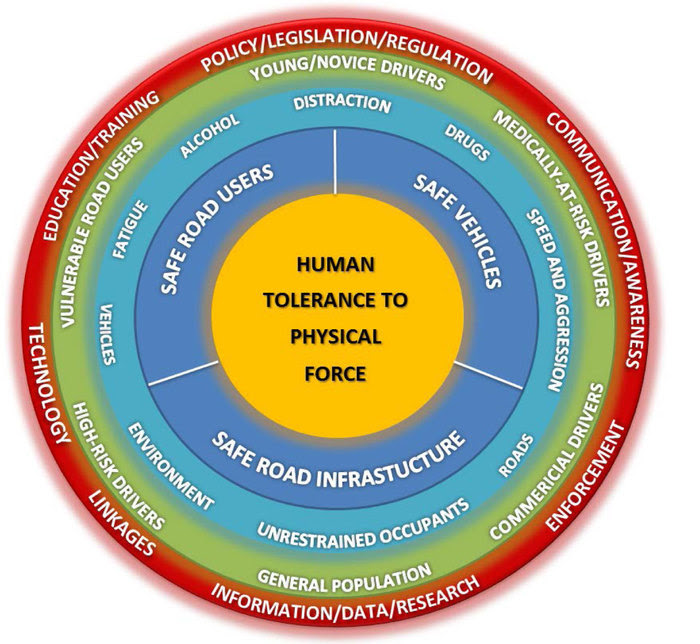Strategy
Road Safety Strategy (RSS) 2025 is similar to its predecessors in a number of ways. It retains the long-term vision of Making Canada’s roads the safest in the world but combines this with the vision of Towards Zero.
A number of principles key to the strategy’s success have been aligned with international best practices in road safety.
These principles include:
- Adopting the Safe System Approach
- A 10-year timeline
- Providing an inventory of proven and promising best practices to address key risk groups and contributing factors
RSS 2025 builds on the work of Road Safety Strategy 2015 with a flexible approach to allow for jurisdictions to implement road safety programs that meet their own needs.
It encourages road safety stakeholders from all levels of government as well as private sector and non-governmental stakeholders to collaborate and unite efforts to make Canada’s roads the safest in the world.
RSS 2025’s vision, “Towards Zero - The safest roads in the world” is based on an international best practice first adopted by Sweden in 1997 where Vision Zero was approved by its parliament and has permeated the country’s approach to road safety ever since. It has resulted in Sweden having among the lowest traffic-related fatality rates world-wide and has led to other countries and municipal governments initiating similar approaches.
Towards Zero is not a target to be achieved by a certain date; it is aspirational. This vision will continue beyond RSS 2025’s timeline and highlights the desire for the best road safety outcomes for all Canadian jurisdictions.
Strategic Objectives
The following strategic objectives form the cornerstone of RSS 2025 and focus on safer road users, road infrastructure and vehicles:
- Raising public awareness and commitment to road safety
- Improving communication, cooperation and collaboration among stakeholders
- Enhancing legislation and enforcement
- Improving road safety information in support of research and evaluation
- Improving the safety of vehicles and road infrastructure
- Leveraging technology and innovation
RSS 2025 Guiding Principles
Adopting a Safe System Approach
The Safe System Approach (SSA) is how many countries leading in road safety are achieving their vision of eliminating deaths and serious injuries. SSA contains the following principles:
- Ethics: human life and health are paramount and take priority over mobility and other objectives of the road traffic system (i.e., life and health can never be exchanged for other benefits within the society)
- Responsibility: providers and regulators of the road traffic system share responsibility with users
- Safety: road traffic systems should take account of human fallibility and minimize both the opportunities for errors and the harm done when they occur
- Mechanisms for change: providers and regulators must do their utmost to guarantee the safety of all citizens; they must cooperate with road users; and all three must be ready to change to achieve safety. It is recognized that Canadian jurisdictions will implement the SSA in a manner that is Appropriate to their environment
Downward Trends
RSS 2025 seeks to achieve directional downward trends in the rate-based number of fatalities and serious injuries rather than in the actual numbers of fatalities and serious injuries. These trends will be measured at the national level annually using multi-year rolling averages to smooth out short-term fluctuations since year-over-year reductions may not be practical or attainable.
Two rate-based indicators commonly used internationally are: fatalities and serious injuries per 100,000 population (World Health Organization, 2014), and fatalities and serious injuries per billion kilometers travelled (Organization for Economic Cooperation and Development and International Transport Forum, 2012). In Canada, the rate-based indicators will be:
- Fatalities and serious injuries per billion kilometres travelled, and
- Fatalities and serious injuries per one hundred thousand population
Although the strategy does not include hard quantitative targets, it does not preclude individual jurisdictions or organizations from establishing their own targets when there is government, law enforcement and/or road safety stakeholder support for doing so.
Online Inventory of Road Safety Best Practices Core to the strategy is an inventory of best practice interventions used by leading road safety countries that have been effective in reducing fatalities and serious injuries. The online inventory can be accessed under the menu tab Road Safety Measures.
A Shared Responsibility
CCMTA is the custodian of Road Safety Strategy 2025 and will be responsible for its update.
Updates may include documenting progress made on new research projects undertaken, identifying new initiatives to be included in the multi-cell matrix of key risk groups and contributing factors, revising the framework of proven best practice initiatives, reporting on progress towards Canada’s vision of Towards Zero - the safest roads in the world.
As custodian of the RSS 2025, the CCMTA, working through the jurisdictions and its committees, task forces, and working groups, will be responsible for maintaining, updating and reporting on the strategy. Given the strategy’s approach, these up-dates may include progress on new research projects, identifying new initiatives, key risk groups or contributing factors.
It is recommended that each jurisdiction develop its own action plans, and in creating these plans, use the road safety measures that have been proven effective in Canada and elsewhere.
Acknowledging the Contributions
CCMTA's Awards Program recognizes individuals and organizations who have contributed to improving road safety in Canada.
Created in support of Canada's Road Safety Strategy 2025, the CCMTA Road Safety Award recognizes CCMTA government members or associates (individuals, groups, departments, and/or organizations) who have implemented strategies aimed at reducing injury and death on Canada's roads.
For additional information on the CCMTA awards including a list of past recipients, visit CCMTA's website.



